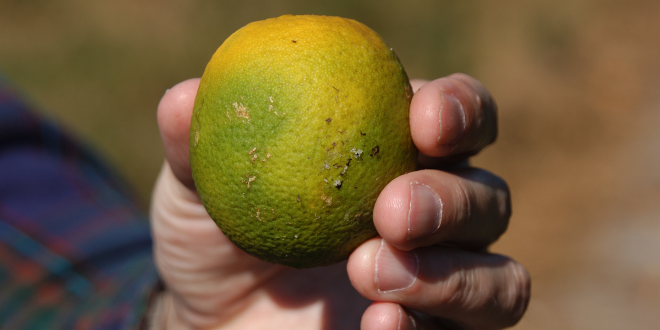California’s Backyard and Commercial Citrus Trees Alike Remain at Risk
SACRAMENTO, Calif. – January 26, 2021 – While COVID-19 is top of mind for all residents of California this year, homeowners and commercial growers are reminded that there is an incurable plant disease, Huanglongbing (HLB), that is still threatening the state’s iconic citrus trees, landscape and economy.
HLB is spread by a tiny but dangerous pest, the Asian citrus psyllid (ACP), as it feeds on citrus tree leaves. The disease is not dangerous to humans or pets, but it is fatal for citrus trees and has no cure. Once a tree is confirmed with the disease, it will inevitably die, and must be removed as soon as possible from the property in order to protect neighboring citrus trees from deadly infection.
The disease was first discovered in California in 2012 in Hacienda Heights. Since then, more than 2,240 HLB-infected trees have been detected and removed, with most occurring in Los Angeles and Orange counties. Currently, more than 1,000 square miles within Southern California in numerous communities of Los Angeles, Orange, San Bernardino and Riverside counties are in an HLB quarantine area. While HLB has not been detected outside these counties, new ACP detections, have occurred in non-infested northern counties (Kern, Madera, San Luis Obispo, Santa Barbara, Santa Clara, Tulare and Contra Costa counties) this past fall, illustrating the ability for the pest to travel to new areas around the state.
The California Department of Food and Agriculture (CDFA) has officials canvassing the state to inspect backyard citrus trees for the ACP and HLB. Homeowners are asked to allow them access to their properties to conduct inspections. Inspectors will be clearly identifiable with a badge and uniform indicating their affiliation with the CDFA, will never need to enter the home, and are trained to observe COVID-19 safety protocols including social distancing and wearing personal protective equipment.
“With more than half of California’s residences estimated to have a citrus tree on their property, homeowners play an instrumental role in helping the Department limit the spread of this dangerous citrus disease,” said Victoria Hornbaker, director of the Citrus Pest and Disease Prevention Division at the CDFA. “We need everyone’s help and cooperation in protecting California’s citrus trees.”
The CDFA has established quarantines throughout the state that limit the transport of citrus across state and international lines, and restrict the movement of residential and commercial citrus from within zones that have HLB to currently unaffected areas. Residential tree owners may choose to share fruit with friends and family within their quarantine area, but all leaves and stems must be removed and fruit washed thoroughly before moving it from the property. Residents should also be sure to dry out citrus clippings or double bag them before disposing. This prevents ACP from spreading to new areas of the state.
All California residents are critical to protecting the state’s citrus trees. Tips for citrus tree owners include:
- Proactively inspect citrus trees for the ACP and HLB monthly, and whenever watering, spraying, pruning or tending trees.
- Look for the ACP. Adults are brown, about one-eighth of an inch long, and feed with their body at a 45-degree angle on citrus leaves.
- Symptoms of HLB include blotchy and yellowing leaves, premature and excessive fruit drop, lopsided fruit, and bitter, inedible fruit.
- Call the state’s pest hotline at 800-491-1899 if the pest or disease is spotted.
- Cooperate with agriculture officials who may ask to inspect or treat citrus trees.
- As part of tree maintenance, visit a local nursery or garden center to get advice on products that can help protect citrus trees.
- When pruning citrus trees, be sure to dry out citrus clippings or double bag them prior to disposal.
- Refrain from moving citrus plants, foliage or fruit as doing this may unknowingly spread the pest.
Should the disease spread from backyard trees to nearby commercial citrus groves, it would endanger California’s citrus production, which contributes $7 billion to the state’s economy, and threaten the livelihoods of the more than 22,000 individuals it employs. HLB has devastated the commercial citrus industry in Florida, which lost $7.8 billion in revenue, 162,200 citrus acres and more than 7,500 jobs over a period of 10 years due to HLB.
“California’s commercial citrus industry and the generations of families it supports is at risk because of HLB,” said Jim Gorden, a citrus grower in the San Joaquin Valley and chair of the Citrus Pest & Disease Prevention Committee. “We must all work together to do what is necessary to protect California’s citrus industry, which supports billions of dollars in our state’s economy.”
More information and photos of the ACP and HLB symptoms are available at CaliforniaCitrusThreat.org.
About the Citrus Pest and Disease Prevention Program The Citrus Pest and Disease Prevention Program is an initiative funded by California citrus growers and administered by the California Department of Food and Agriculture dedicated to combatting serious pests and diseases that threaten the state’s citrus trees.
More California News – https://www.crossingstv.com/news-events/news-events-california/
 Crossings TV Asian Television – Home to Asian Americans
Crossings TV Asian Television – Home to Asian Americans
